
When looking to connect with investors, clients, and stakeholders, roadshow presentations become a platform for companies to showcase their products, services, and overall vision. This key opportunity helps people outside your organization to evaluate your potential and decide whether to invest or commit as a consumer.
Unlike regular presentations, roadshows require a unique blend of strategic planning abilities, adaptability to shifting environments – given that a good number of roadshow presentations happen outside the company’s local area – and audience engagement. Presenters must be ready to tailor their message to different audiences and handle the logistics of presenting in various locations. This complexity is why today we will learn the elements that make a successful roadshow presentation, highlighting the presenter’s capabilities. Join us to discover the ideal structure of a roadshow presentation, how to tailor the content to include depending on your objectives, and insights to perform like a professional presenter.
Table of Contents
- What is a Roadshow?
- What is a Roadshow Presentation?
- Benefits of Roadshow Presentations
- What Should Be Included in a Roadshow Presentation?
- Do’s and Don’ts of Roadshow Presentations
- FAQs
- Final Words
What is a Roadshow?
According to the Cambridge Dictionary, a roadshow is “a series of shows or events that occur in different places across the country, for entertainment or to give the public information about a company, product, etc.”
The events in question would be presentations, and an organization or company typically makes them across different target markets during their Initial Public Offering (IPO) process. Although initially intended to attract investors, roadshows evolved to serve multiple purposes, including business development, networking, and product launches. It is a unique opportunity to engage directly with the audience and can be held in live format or digitally through webinars.
What is a Roadshow Presentation?
A roadshow presentation is a formal presentation delivered during a roadshow event. It conveys key information about the company, its products or services, financial performance, market position, and future prospects. The core difference between a typical corporate presentation and a roadshow presentation is that the latter is tailored to the specific location, addressing regional interests and concerns.
Because of such specific requirements, roadshow presentations must be carefully planned based on studying the region and local actors in the industry and evaluating the public’s primary necessities for the company’s niche. Sometimes, the answers may not seem apparent, hence the importance of multidisciplinary team planning for roadshow presentations.
Benefits of Roadshow Presentations
Direct Audience Engagement
Rather than waiting for feedback that may not deliver conclusive results, roadshow presentations are face-to-face interactions that allow presenters to gauge audience reactions. By addressing questions in real-time, the presenter can introduce data that may not seem relevant in previous regional studies but somehow fit the context. This implies that the preparation done for an earlier event directly impacts future situations.
Graphics play a significant role in this regard. Visual communication is a driving force for audience engagement. Consider working with layout designs that condense information into sections using colors or icons for faster recall.

Enhanced Brand Visibility
Traveling to multiple locations and delivering presentations to diverse audiences can significantly increase your brand’s exposure. Roadshows help to put your company’s name on the map, especially in remote locations where there are not enough competitors for some niches, and can even lead to opportunities such as targeting non-exploited markets.
Networking Opportunities
Roadshows are excellent scenarios for growing your contact network. Think of it as a real-life LinkedIn, where potential investors, industry professionals in your area, and other valuable connections are within reach. This can become partnerships, new business deals, or even talent acquisition.
If you intend to drive investors toward your offering, consider making room for an Investor Pitch Deck Presentation inside your roadshow presentation. You can merge both presentations as long as your slides remain aesthetically cohesive and follow a logical flow.

What Should Be Included in a Roadshow Presentation?
Each element of the roadshow presentation must work together to craft a cohesive and persuasive story that convinces the audience of your company’s value offer and potential. Here are the main components of any roadshow presentation.
Company Overview
The roadshow presentation should begin with a concise overview of your company. This section sets the stage for the rest of the presentation, and the elements to list inside the company overview section are:
- Mission and Vision: Your company’s mission and vision statements are a must, as they describe your work ethic, the reason you are in business, and your long-term goals and aspirations.
- History and Milestones: In a storytelling format, you should speak of your company’s main achieved milestones and the process that drove your organization to where it currently stands. Founding dates, significant achievements, awards, etc., help to build credibility and demonstrate your company’s growth process and resilience.
- Core Values: Concisely describe the company’s core values and culture, as this is a means to humanize the conversation, especially if you’re seeking to attract investors or hire new talent. These values speak about a company’s management ethics and work discipline, and investors address the importance of a company’s values as part of the business strategy.
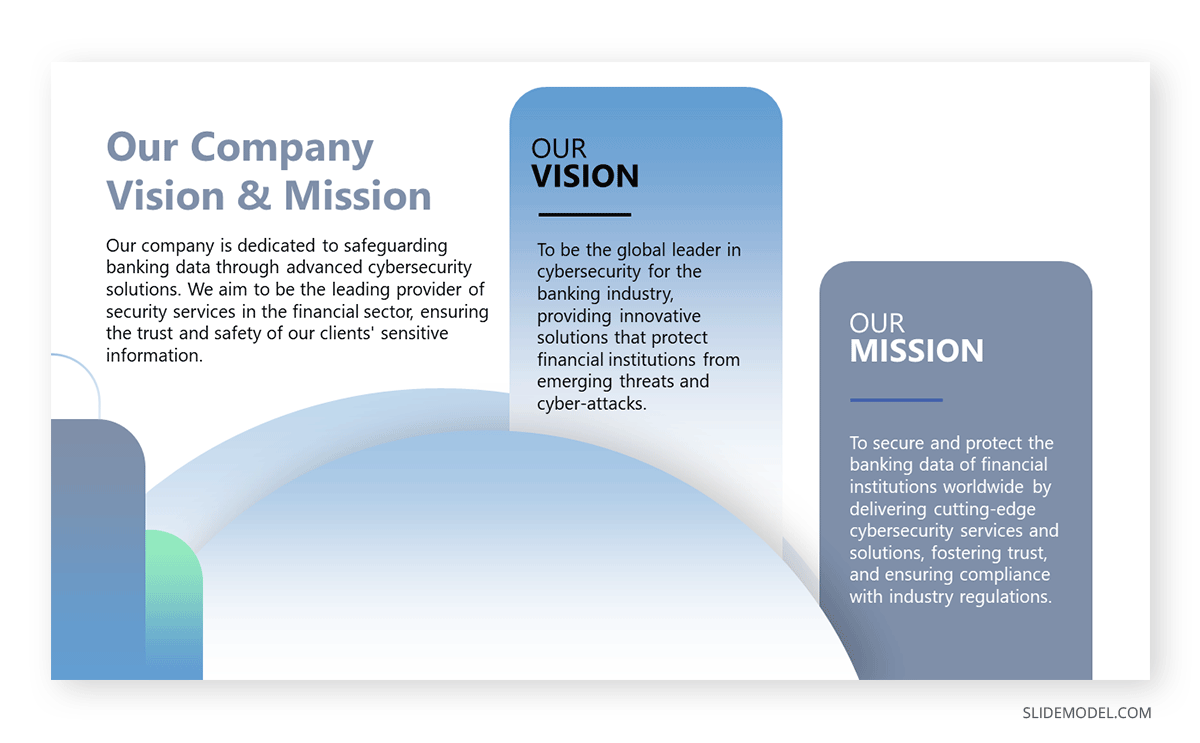
Leadership Team: An organizational chart can be used to present your managerial structure, and brief bios and photos can be used to introduce key team members. Emphasize their experience, expertise, and contributions to the company.
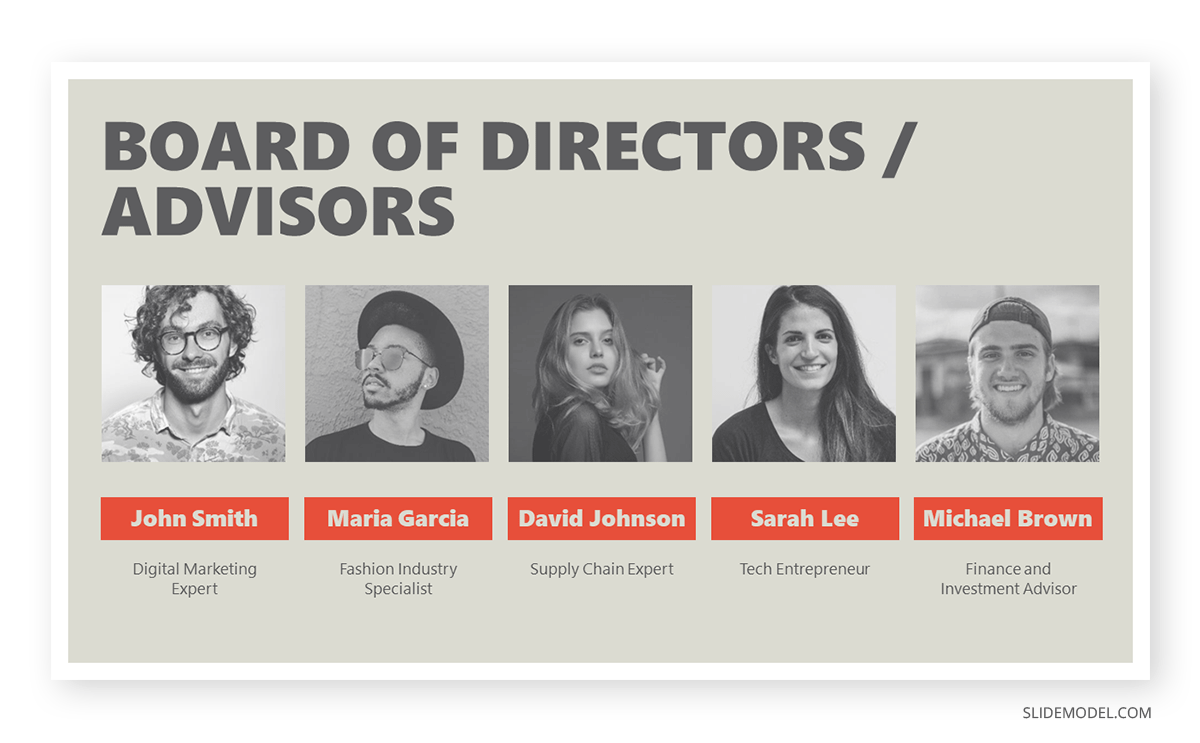
Product or Service Demos
This section discusses what you offer to the market and why it is valuable. Several approaches can be taken, which we shall present below.
Unique Selling Points (USPs)
Using a USP slide, the presenter can highlight the features and benefits differentiating the product/service from the competition. A key element is to specify why your offer is unique and how it serves the target market.
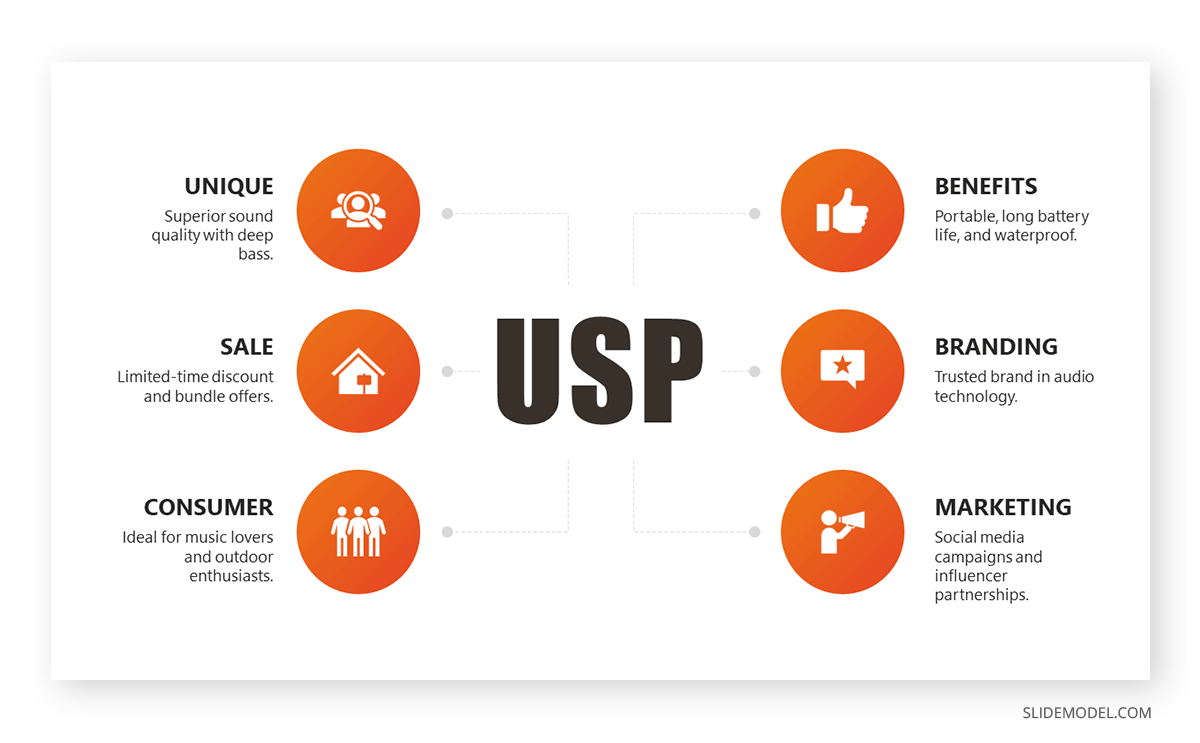
Live Demos
If the situation allows it, nothing works best than a live demonstration of what you offer. It is the highest persuasive element you can include in a face-to-face presentation and works significantly better than describing or using a video presentation.
Set the stage for your product or service in ideal conditions. Practice and rehearse as many times as necessary to pinpoint any potential technical glitches or learn to use them to your benefit (e.g., explain to the user how to troubleshoot a situation in real-time).
Customer Success Stories
Both customers and investors seek social proof of the product or service’s quality. Using real-life testimonials, which can be depicted in video format, with metrics or testimonials reinforces your company’s credibility.
Invest time and money in customer experience (CX) in a manner that naturally builds your brand’s success story. You can showcase testimonials from your website and third-party services like TrustPilot or implement customer rewards programs that deliver a discount or special product for a trustworthy review of their experience with your brand.
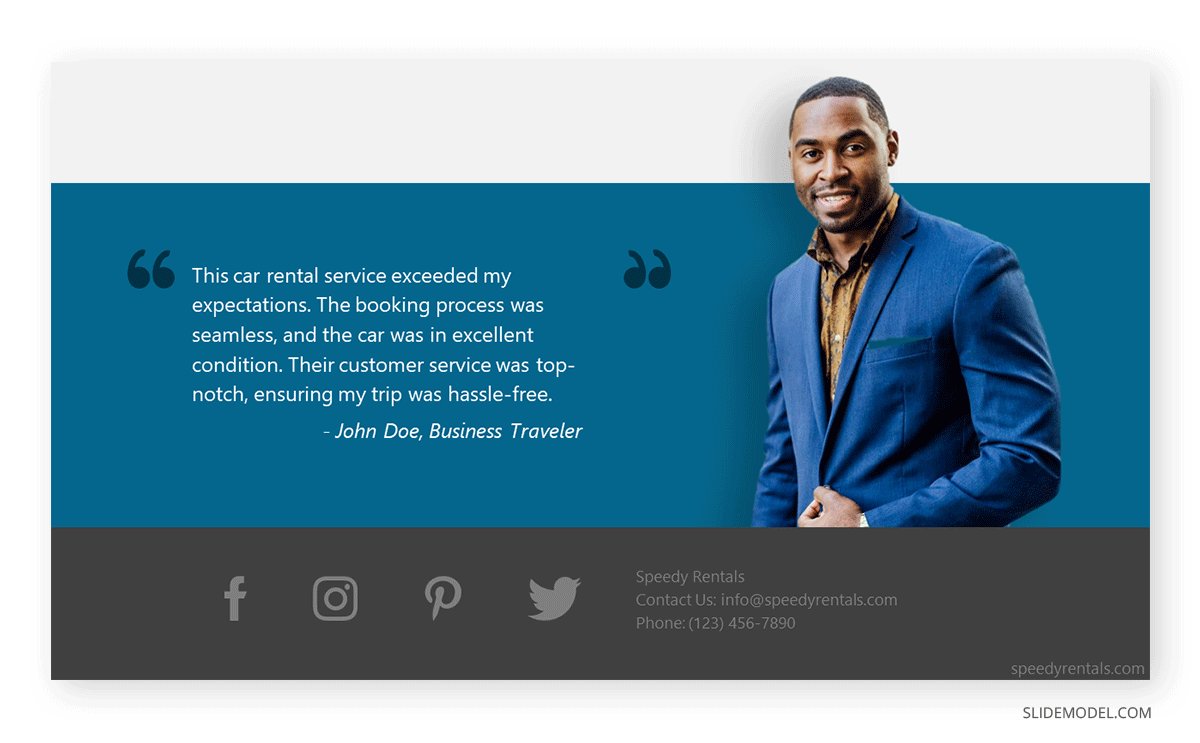
Product Roadmap
Another wow factor to use in specific markets is to present your future releases according to your product development strategy. Through a product roadmap, investors can understand your production process, the collaborations between teams, which external factors may influence your delivery capacity, and if any cutting-edge technology is to be released by your team’s research.

Market Analysis
A thorough market analysis is required to showcase your business’s viability and growth potential. Four main elements should be considered when creating this section, starting with market size, which can be represented through the TAM SAM SOM model.

Market segmentation follows, defining your ideal buyer persona through demographics and their needs.
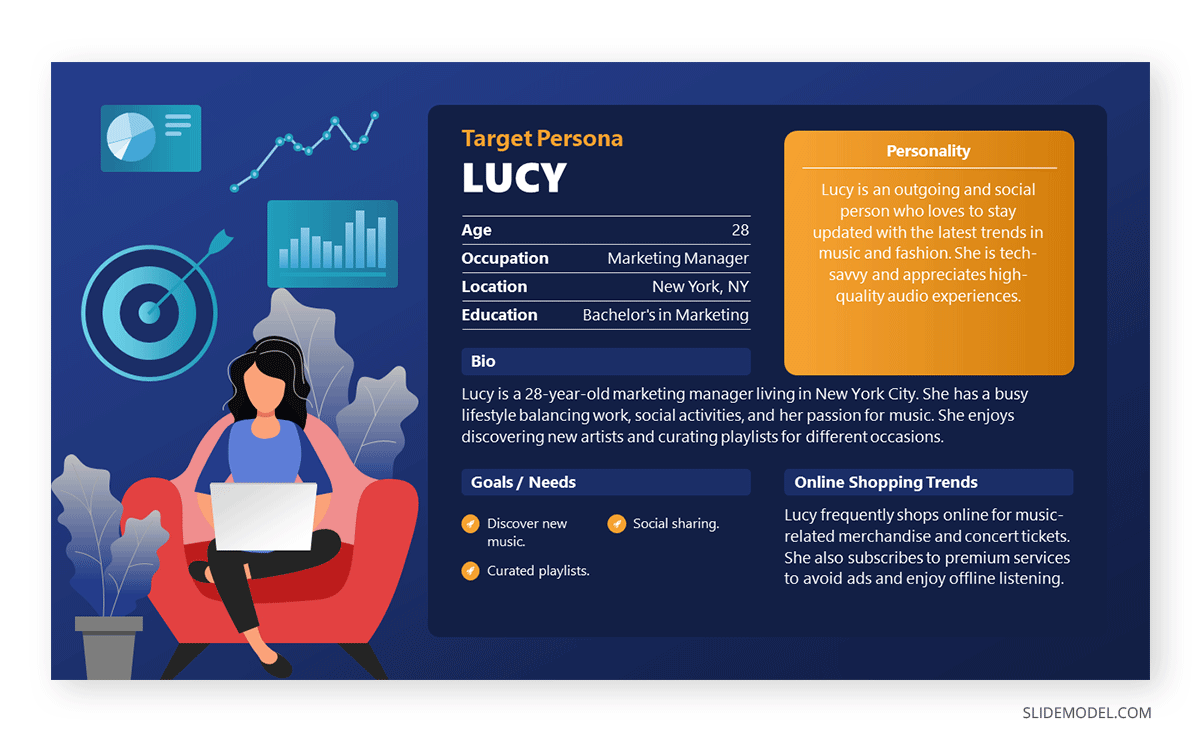
The competitive landscape analysis requires listing your main competitors, their strengths and weaknesses, and what’s your differential factor. By doing this, you establish your company’s position in the industry and highlight your competitive advantages – which can be managed by creating a competitive landscape slide or a competitor SWOT analysis.
Business Model
The business model is a blueprint for how your company generates revenue and remains profitable. Ideally, we should list the following elements:
- Revenue Streams: Outline your primary revenue sources, including product/service sales, subscription fees, licensing, advertising, etc. Use a pie chart to show how each revenue stream contributes to the overall monthly income.
- Cost Structure: Include fixed and variable costs to help the audience understand your financial dynamics. You can learn more about this topic in our guide on presenting a cost structure.
- Pricing Strategy: Describe how the pricing strategy aligns with your value proposition and market positioning. If any adjustments are to be made, be sure to mention them.
- Sales Channels and Distribution: Highlight the efficiency of your distribution strategy and detail all sales funnels and channels. In particular, stress the importance of social media as a channel in your current numbers to demonstrate your connection with the audience.
- Customer Acquisition and Retention: Explain your strategies for acquiring or retaining new customers. Be specific about your marketing plans.
Financials
This section is particularly interesting to investors, and the models mentioned in it are available in Investor PowerPoint Templates. Basically, you need to talk about your company’s financial health and future potential.
In our experience, it’s best to summarize this section by explaining return on investment (ROI), EBITDA, and gross margin. You can then present the funding and capital structure, especially if grants or loans were involved in your company’s early stages. Our article on business plan presentations provides a highly detailed guide on presenting these elements.
Risk management is another key factor directly impacting your financial projections. Our guide on risk analysis and risk management provides insights on how to present such data properly.
Do’s and Don’ts of Roadshow Presentations
Do’s
Customize for Each Audience
Tailor your presentation to the specific audience at each location. Customize your content, examples, and messaging to address regional interests and preferences. Personalization enhances relevance and engagement.
Use Clear and Concise Visuals
Visuals play a crucial role in roadshow presentations. Use clear and concise visuals to illustrate key points and data. Avoid overcrowded slides and ensure that your visuals are easily understood at a glance.
Prepare for Rigorous Q&A Sessions
Anticipate potential questions and prepare thorough answers. Q&A sessions are an opportunity to demonstrate your expertise and address any concerns. Being well-prepared shows confidence and credibility.
Follow Up Promptly
After each presentation, follow up promptly with attendees. Send thank-you notes, additional information, and any promised materials. Following up helps reinforce your message and maintains the momentum generated during the roadshow.
Don’ts
Avoid Overloading Content
Resist the temptation to include too much information in your presentation. Overloading content can overwhelm the audience and dilute your key messages. Focus on the most important points and present them clearly. Our article on presentation structure can help to understand the importance of this point.
Don’t Neglect Logistics
Logistical issues can disrupt your presentation and create a negative impression. Pay attention to every detail, from travel arrangements to technical setup, to ensure a smooth and professional experience.
Avoid Jargon Without Explanation
While industry jargon may be familiar to you, it may not be understood by all audience members. Avoid jargon without explanations, and ensure your language is accessible to everyone.
Don’t Ignore Cultural Sensitivity
When presenting in different regions, be mindful of cultural differences. Respect local customs and sensitivities in your content and delivery. Cultural sensitivity helps build rapport and avoids misunderstandings. Check this guide on public speaking for more insights.
FAQs
How long should a typical roadshow presentation last?
The ideal length of a roadshow presentation varies, but it typically ranges from 30 to 60 minutes. This allows enough time to cover key points while keeping the audience engaged. Ensure you leave time for a Q&A session at the end.
How do you measure the success of a roadshow presentation?
Success can be measured through various metrics, including audience engagement, feedback, number of follow-up meetings or inquiries, and achieving specific goals such as securing investments or partnerships.
What are the most common mistakes in roadshow presentations, and how can they be avoided?
Common mistakes include overloading content, poor logistics management, lack of audience engagement, and inadequate preparation for Q&A sessions. These can be avoided through thorough planning, audience analysis, and practice.
Can virtual elements be integrated into a traditional roadshow?
Yes, integrating virtual elements can enhance a traditional roadshow. This includes live-streaming presentations, using digital tools for audience interaction, and offering virtual follow-up sessions. Virtual elements expand reach and accessibility.
What are the best practices for follow-up after a roadshow presentation?
Best practices for follow-up include sending personalized thank-you notes, providing additional information or materials, scheduling follow-up meetings, and maintaining regular communication with attendees. Prompt and personalized follow-up reinforces your message and builds relationships.
Final Words
Roadshow presentations are a powerful medium to connect with industry decision-makers and consumers alike, showcasing your company’s strengths and promoting business growth. By understanding the fundamentals of this craft, your presentation skills can do the rest to create a memorable roadshow presentation.
If your aim is to work in digital format for this particular type of presentation, we highly recommend reaching high-authority websites and forums for the maximum advertising exposure of your event or signing up for large online events in roadshow presentation format.


